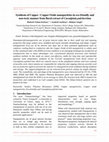Papers by Rinkesh Kurkure
Eco-Friendly Synthesis of Zinc Oxide Nanoparticles and its Anti-bactrial Activity for Rayon Pulp

Nanomaterials/nanoparticles are of great interest today due to their small size and amazing prope... more Nanomaterials/nanoparticles are of great interest today due to their small size and amazing properties like large surface area, modified and easily tuneable morphology and shape. Copper nanoparticles (Cu) are of lot interest now days due to their potential applications such as catalysis, cooling fluid or conductive inks the Copper Oxide (CuO) nanoparticle is widely used in Dye sensitized solar cells (DSSCs).Green synthesis is an emerging technique for production of nanoparticles due to many advantages over conventional physical processes and chemical synthesis method. In this study we report cost-effective, stable for long time and reproducible aqueous room temperature synthesis of the Cu/CuO nanoparticles from floral extract of Caesalpinia pulcherrima which are natural source of the polyphenol tannins and trace amount of ascorbic acid, where tannins are responsible for reduction and capping whereas ascorbic acid acts as protective agent to prevent the nascent Cu nanoparticles from oxidation during synthesis and storage. The capped polyphenols can be removed from particle surface by simple ethanoic wash. The crystallinity, size and shape of the nanoparticles were characterized by UV-Vis, FTIR, XRD, EDAX and SEM. The Surface Plasmon Resonance peak was observed at 380 nm and amalgamated size from the SEM is on an average to 20nm.The structure from XRD is found to be monoclinic and confirmed it as CuO complex from EDAX. The Debye-Scherer particle size is found to be 6nm.











Uploads
Papers by Rinkesh Kurkure